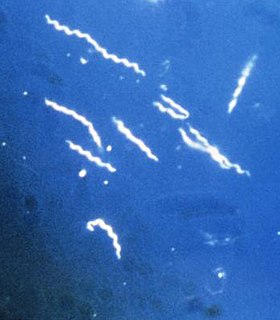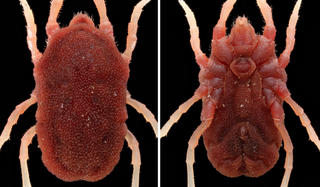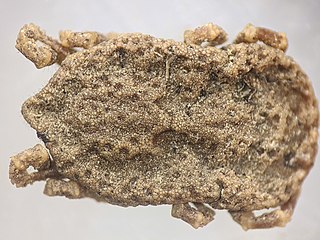
A spirochaete or spirochete is a member of the phylum Spirochaetes, which contains distinctive diderm (double-membrane) gram-negative bacteria, most of which have long, helically coiled cells. Spirochaetes are chemoheterotrophic in nature, with lengths between 3 and 500 μm and diameters around 0.09 to at least 3 μm.
Tick-borne diseases, which afflict humans and other animals, are caused by infectious agents transmitted by tick bites. They are caused by infection with a variety of pathogens, including rickettsia and other types of bacteria, viruses, and protozoa. Because individual ticks can harbor more than one disease-causing agent, patients can be infected with more than one pathogen at the same time, compounding the difficulty in diagnosis and treatment. 16 tick-borne diseases of humans are known, of which four have been discovered since 2013.

Borrelia burgdorferi sensu stricto is a bacterial species of the spirochete class in the genus Borrelia, and is one of the causative agents of Lyme disease in humans. Along with a few similar genospecies, some of which also cause Lyme disease, it makes up the species complex of Borrelia burgdorferi sensu lato. The complex currently comprises 20 accepted and 3 proposed genospecies. B. burgdorferi sensu stricto exists in North America and Eurasia and until 2016 was the only known cause of Lyme disease in North America. Borrelia species are gram-negative.
Relapsing fever is a vector-borne disease caused by infection with certain bacteria in the genus Borrelia, which is transmitted through the bites of lice or soft-bodied ticks.

Borrelia is a genus of bacteria of the spirochete phylum. It causes Lyme disease, also called Lyme borreliosis, a zoonotic, vector-borne disease transmitted primarily by ticks and by lice, depending on the species of bacteria. The genus is named after French biologist Amédée Borrel (1867–1936), who first documented the distinction between a species of Borrelia, B. anserina, and the other known type of spirochete at the time, Treponema pallidum. This bacterium must be viewed using dark-field microscopy, which make the cells appear white against a dark background. Borrelia species are grown in Barbour-Stoenner-Kelly medium. Of 52 known species of Borrelia, 20 are members of the Lyme disease group, 29 belong to the relapsing fever group, and two are members of a genetically distinct third group typically found in reptiles. The Lyme disease group has been proposed to be split based on genetic diversity and moved to their own genus, Borelliella, but this change is not widely accepted. This bacterium uses hard and soft ticks and lice as vectors. Testing for the presence of the bacteria in a human includes two-tiered serological testing, including immunoassays and immunoblotting.

Wilhelm Burgdorfer was an American scientist born and educated in Basel, Switzerland, considered an international leader in the field of medical entomology. He discovered the bacterial pathogen that causes Lyme disease, a spirochete named Borrelia burgdorferi in his honor.

Lyme disease, or borreliosis, is caused by spirochetal bacteria from the genus Borrelia, which has 52 known species. Three main species are the main causative agents of the disease in humans, while a number of others have been implicated as possibly pathogenic. Borrelia species in the species complex known to cause Lyme disease are collectively called Borrelia burgdorferisensu lato (s.l.) not to be confused with the single species in that complex Borrelia burgdorferi sensu stricto which is responsible for nearly all cases of Lyme disease in North America.

Borrelia hermsii is a spirochete bacterium that has been implicated as a cause of tick-borne relapsing fever. It is spread by the soft-bodied tick Ornithodoros hermsi.

Borrelia recurrentis is a species of Borrelia, a spirochaete bacterium associated with relapsing fever. B. recurrentis is usually transmitted from person to person by the human body louse. Since the 1800s, the body louse has been known as its only known vector.
Carios erraticus, formerly called Ornithodoros erraticus, is a species of tick in the family Argasidae. The tick was described by Hippolyte Lucas in 1849.

Ornithodoros hermsi is a species of soft tick. It can be infected with Borrelia hermsii.
Borrelia parkeri, a species of Borrelia, has been associated with relapsing fever.
Borrelia duttoni, formerly known as Spirochaeta duttoni, is a species of Borrelia.

Ornithodoros moubata, commonly known as the African hut tampan or the eyeless tampan, is a species of tick in the family Argasidae. It is an ectoparasite and vector of relapsing fever in humans, and African swine fever in pigs.

Ornithodoros turicata, commonly referred to as the relapsing fever tick, is a soft tick found in the midwestern and southwestern United States. It is a known vector of Borrelia turicatae, a spirochete responsible for tick-borne relapsing fever in humans. Additionally, vector competence for the transmission of Leptospira pomona, the agent of canine jaundice, has been demonstrated in a laboratory setting.
Borrelia miyamotoi is a spirochete bacterium in the genus Borrelia. A zoonotic bacterium, B. miyamotoi can be transferred to humans through the hard (Ixodes) ticks, the same tick species that spread B. burgdorferi, the causative agent of Lyme disease, and Babesia microti, the causative agent of babesiosis. Although infection can cause some similar symptoms including fever, headache, fatigue, and muscle aches, acute Lyme disease often presents with rash, while infection with B. miyamotoi does not; it remains unclear whether B. miyamotoi causes a relapsing fever syndrome.
Borrelia sinica is a spirochete bacterium. Its cells contain only four periplasmic flagella inserted at each end of the spirochaetes, differing from other Borrelia species. It is associated with Lyme disease. CMN3T is the type strain of this species.
Borrelia turicatae is a bacterial species of the spirochaete class of the genus Borrelia. It is one of the relapsing fever spirochaetes, which are globally distributed yet understudied agents of tick-borne relapsing fever. The tick vector Ornithodoros turicata transmits B. turicatae, which causes relapsing fever, an arthropod-borne infection of humans and other mammals caused by different Borrelia species. B. turicatae is long and spiral-shaped, as is typical for all spirochaetes. It is a Gram-negative bacterium and visible with light microscopy. Few epidemiological studies have been performed and few molecular data exist for B. turicatae and its arthropod vector O. turicata.

Ornithodoros savignyi, known as sand tampan, African eyed tampan or Kalahari sand tampan, is one of some 37 species in the genus Ornithodoros and is a soft tick with a leathery, mammillated integument, causing paralysis and tampan toxicosis, two unrelated conditions. The sand tampan is an ectoparasite on humans, their livestock and wild animals, including birds and bats. Occurring in semi-desert areas of Africa, Saudi Arabia and other parts of the Persian Gulf, India, Sri Lanka and into Asia, it is able to survive for lengthy periods without feeding, spending most of its life burrowed under sand or loose soil, often in wait for animals that rest or sleep under trees or in the lee of rocks, but also in places where people or their animals congregate such as marketplaces, places of worship, cattle kraals and village squares. The timing of its activity is geared to coincide with that of potential hosts, but hot sunny conditions are usually avoided. Because of its habit of feeding and dropping from its host, adult dispersal is limited, whereas larvae may remain attached to their hosts for several days. During its life cycle it will feed on multiple hosts between moults.

Ornithodoros coriaceus, the Pajahuello or Pajahuello tick, is a tick that feeds on the blood of mammals and birds. It is widely distributed throughout western North America from southern Mexico to Oregon. Although this species rarely bites humans its bite is considered to be particularly painful. It is the primary vector of the bacterium that causes Epizootic Bovine Abortion, a severe and commercially-important disease afflicting domestic cattle.










